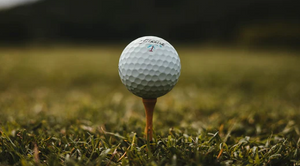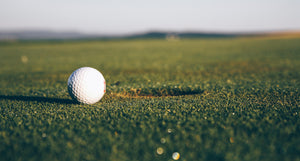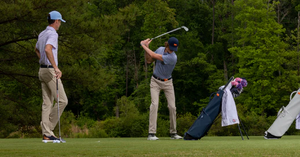What Is a Provisional in Golf?
When playing golf, you’ve likely encountered a situation when a provisional ball could be played. A provisional in golf allows a player to re-hit the ball without having to walk back to the last stroke if they believe the ball is lost or out of bounds. The USGA has very specific rules regarding when and how to play a provisional ball.
Keep reading to learn when to play a provisional ball, its requirements, and when you can't play it.
When Are You Allowed To Play a Provisional Ball?
The provisional ball is perhaps one of the most helpful rules in the USGA. Outlined in Rule 27, the purpose of this rule is to help keep the pace of the game, allowing players to continue instead of searching for their ball or walking back to the original stroke spot.
You're allowed to play a provisional ball if you think your shot is lost or out of bounds. Additionally, the best time to hit a provisional ball is before you walk away from the original stroke and search for the ball. If you cannot find the ball when searching or discover it is out of bounds, you'll have to walk back to the original stroke. Stroke and distance relief are still used for a provisional ball, but now the player doesn't have to trek back to where the original ball was shot from. Stroke-and-distance relief is a stroke penalty for the lost or out-of-bounds ball.
After you take the shot, you need to know when to reasonably assume a ball is lost or out of bounds. According to USGA, a lost ball cannot be found within three minutes of searching. Since the purpose of the provisional is to save time, there's a time limit on how long you can search for the ball. If you don't hit a provisional ball and your ball is determined to be lost, you have to return to the original stroke spot.
For example, if the golf ball goes into a patch of trees with high weeds or tall grass, a provisional ball is usually hit. If the ball is found, the provisional ball is abandoned without any penalty. There are many practices to help you to stop losing golf balls. If you find that many of your balls are becoming lost practicing your aim, using a range finder may help.
Out of bounds is any area outside the course's boundary line. All ground inside the boundary is within bounds, including artificial objects. If an object is half inside and half outside, the part of it inside boundary is in. For example, you might come across tree roots that extend from outside the boundary to inside. The roots residing inside the boundary don't necessitate putting the provisional ball into play.
Just because a provisional ball was hit doesn't mean it is the ball in play– yet. The three-minute search period must be conducted first. If the original ball is found or is in bounds, the provisional ball won't count. If the first ball is not found, then the provisional ball is in play.
How to Play a Provisional Ball
There is more to playing a provisional ball than meets the eye. Here are a few guidelines to remember to ensure understanding across the board.
Requirement for Announcing a Provisional Ball
Before playing a provisional ball, the intention should be made clear to all participants. Simply stating that you are going for “another hit” is not sufficient. Without clarity, any ball you hit will be counted as a second ball, a stroke will be used, and the first ball cannot be played anymore.
This is an important step. If you don't announce the provisional ball, it can still become the ball in play but under penalty of stroke and distance. Don't worry - this is a common mistake that can be easily avoided. Make sure to say the word “provisional,” and you will be good to go.
Timing for Playing a Provisional Ball
The timing around playing this ball can be confusing for many players. The provisional ball should be hit before searching for the initial shot. Once the second shot is taken, you'll have three minutes to search for the original one. If the ball is not found, the stroke and distance relief are enacted with the provisional ball. The player then takes one penalty stroke for losing the ball or shooting it out of bounds.
To clarify, the player does not have to hit the provisional ball. It can be hit anytime within the three-minute search. This is useful if searching a short distance, like 50 yards. However, it's best practice to hit on if you have a lot of ground to search in.
Circumstances Where Playing a Provisional Ball is Not Allowed?
Playing a provisional ball is a great way to save time during the game. However, there are restrictions to enacting Rule 27. Understanding these restrictions will help you be a better player and avoid wasting time or gaining excess penalties.
A common misconception is when the first shot is hit into a water hazard or other penalty area. This is a trap that takes the golf balls of many players. In this instance, the player should take penalty relief. Under this Rule, the player can take a stroke and distance penalty, a back-on-the-line relief, or a lateral relief.
If a provisional ball was hit, it must be abandoned. Once the ball is found to be in a penalty area, the player now has three options for relief. The player can go back and hit another ball, taking a stroke-and-distance relief similar to a provisional ball. The original provisional ball was hit before the player had three relief options, so it isn't fair if the outcome of one option is known.
Frequently Asked Questions
What Does Hitting a Provisional Mean in Golf?
A provisional is the second ball you hit if you think your first shot is lost or out of bounds. The purpose of hitting a provisional is to keep the game's pace. To play the provisional ball, the original ball must be searched for. There are three minutes allowed to search for the ball before it is counted as lost.
How Many Strokes Do You Take for a Provisional?
A provisional ball enacts the stroke and distance relief penalty, meaning you’ll take a stroke for the original ball hit. A second stroke for losing the ball or hitting it out of bounds. Finally, a third stroke for hitting the provisional ball.
Why Take a Provisional Instead of a Drop?
A player should take a provisional in case the ball is out of bounds or lost. If the provisional is not clearly taken, and the ball is hit out of bounds or lost, you’ll have to take a drop. You risk losing the yardage you could have gained with the provisional.
Final Thoughts
The rules and subtleties around a provisional ball can be confusing for a lot of players, beginners and advanced alike. A provisional ball is a secondary ball hit when you think your ball is lost or out of bounds to save the pace of play. Remember to announce to the other players your intentions to play a provisional ball and conduct the necessary search.
Good news: you’re now prepared for action if you think you’ve lost your ball or hit it out. Stitch Golf’s gear and apparel will have you prepared to play your best game.



